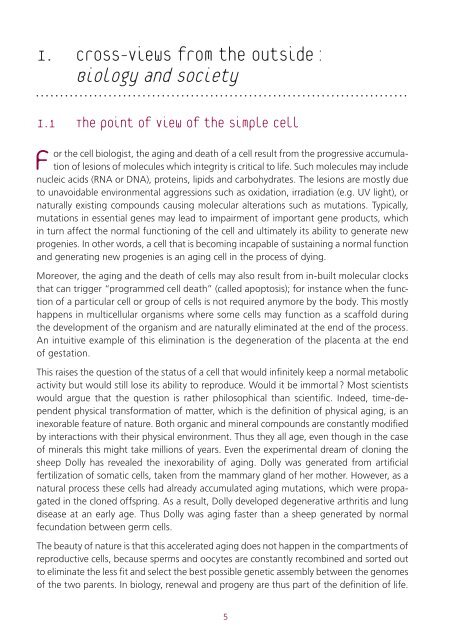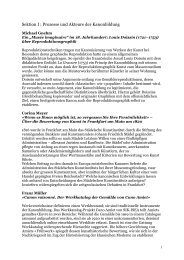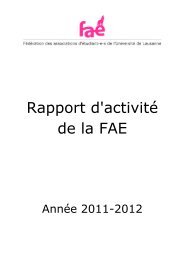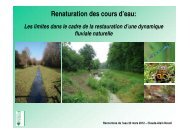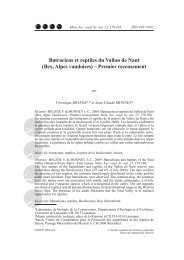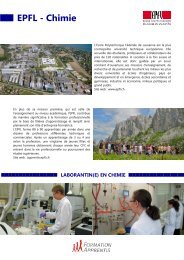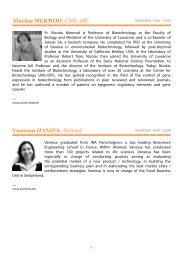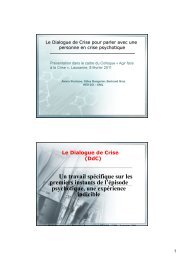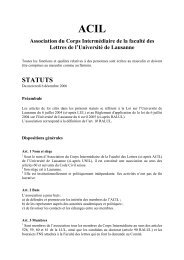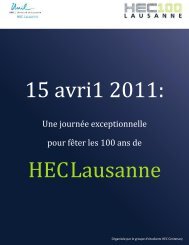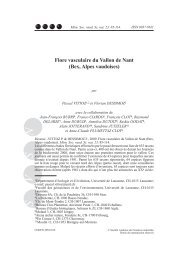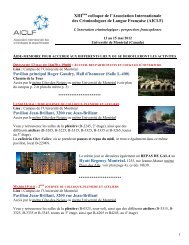a summary of the topics - Université de Lausanne
a summary of the topics - Université de Lausanne
a summary of the topics - Université de Lausanne
You also want an ePaper? Increase the reach of your titles
YUMPU automatically turns print PDFs into web optimized ePapers that Google loves.
I. C r o s s-vi e w s fr o m t h e O u t si d e :<br />
Bi ol o g y a n d S o ci e t y<br />
I.1 The point <strong>of</strong> view <strong>of</strong> <strong>the</strong> simple cell<br />
For <strong>the</strong> cell biologist, <strong>the</strong> aging and <strong>de</strong>ath <strong>of</strong> a cell result from <strong>the</strong> progressive accumulation<br />
<strong>of</strong> lesions <strong>of</strong> molecules which integrity is critical to life. Such molecules may inclu<strong>de</strong><br />
nucleic acids (RNA or DNA), proteins, lipids and carbohydrates. The lesions are mostly due<br />
to unavoidable environmental aggressions such as oxidation, irradiation (e.g. UV light), or<br />
naturally existing compounds causing molecular alterations such as mutations. Typically,<br />
mutations in essential genes may lead to impairment <strong>of</strong> important gene products, which<br />
in turn affect <strong>the</strong> normal functioning <strong>of</strong> <strong>the</strong> cell and ultimately its ability to generate new<br />
progenies. In o<strong>the</strong>r words, a cell that is becoming incapable <strong>of</strong> sustaining a normal function<br />
and generating new progenies is an aging cell in <strong>the</strong> process <strong>of</strong> dying.<br />
Moreover, <strong>the</strong> aging and <strong>the</strong> <strong>de</strong>ath <strong>of</strong> cells may also result from in-built molecular clocks<br />
that can trigger “programmed cell <strong>de</strong>ath” (called apoptosis); for instance when <strong>the</strong> function<br />
<strong>of</strong> a particular cell or group <strong>of</strong> cells is not required anymore by <strong>the</strong> body. This mostly<br />
happens in multicellular organisms where some cells may function as a scaffold during<br />
<strong>the</strong> <strong>de</strong>velopment <strong>of</strong> <strong>the</strong> organism and are naturally eliminated at <strong>the</strong> end <strong>of</strong> <strong>the</strong> process.<br />
An intuitive example <strong>of</strong> this elimination is <strong>the</strong> <strong>de</strong>generation <strong>of</strong> <strong>the</strong> placenta at <strong>the</strong> end<br />
<strong>of</strong> gestation.<br />
This raises <strong>the</strong> question <strong>of</strong> <strong>the</strong> status <strong>of</strong> a cell that would infinitely keep a normal metabolic<br />
activity but would still lose its ability to reproduce. Would it be immortal ? Most scientists<br />
would argue that <strong>the</strong> question is ra<strong>the</strong>r philosophical than scientific. In<strong>de</strong>ed, time-<strong>de</strong>pen<strong>de</strong>nt<br />
physical transformation <strong>of</strong> matter, which is <strong>the</strong> <strong>de</strong>finition <strong>of</strong> physical aging, is an<br />
inexorable feature <strong>of</strong> nature. Both organic and mineral compounds are constantly modified<br />
by interactions with <strong>the</strong>ir physical environment. Thus <strong>the</strong>y all age, even though in <strong>the</strong> case<br />
<strong>of</strong> minerals this might take millions <strong>of</strong> years. Even <strong>the</strong> experimental dream <strong>of</strong> cloning <strong>the</strong><br />
sheep Dolly has revealed <strong>the</strong> inexorability <strong>of</strong> aging. Dolly was generated from artificial<br />
fertilization <strong>of</strong> somatic cells, taken from <strong>the</strong> mammary gland <strong>of</strong> her mo<strong>the</strong>r. However, as a<br />
natural process <strong>the</strong>se cells had already accumulated aging mutations, which were propagated<br />
in <strong>the</strong> cloned <strong>of</strong>fspring. As a result, Dolly <strong>de</strong>veloped <strong>de</strong>generative arthritis and lung<br />
disease at an early age. Thus Dolly was aging faster than a sheep generated by normal<br />
fecundation between germ cells.<br />
The beauty <strong>of</strong> nature is that this accelerated aging does not happen in <strong>the</strong> compartments <strong>of</strong><br />
reproductive cells, because sperms and oocytes are constantly recombined and sorted out<br />
to eliminate <strong>the</strong> less fit and select <strong>the</strong> best possible genetic assembly between <strong>the</strong> genomes<br />
<strong>of</strong> <strong>the</strong> two parents. In biology, renewal and progeny are thus part <strong>of</strong> <strong>the</strong> <strong>de</strong>finition <strong>of</strong> life.<br />
5


